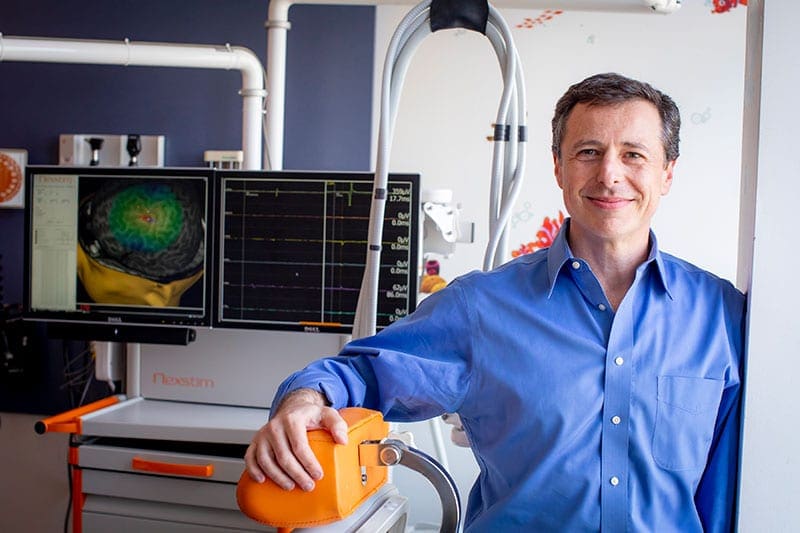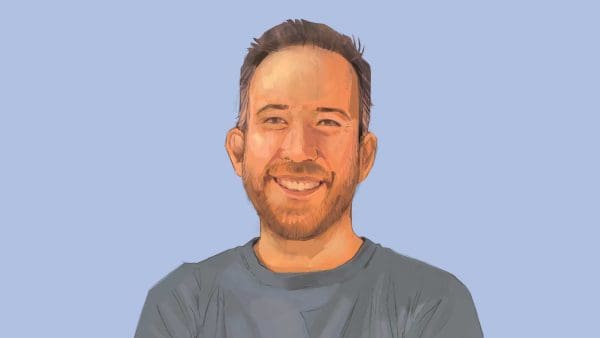When someone has a brain injury—an infection, say, or a hemorrhage from a blow to the head—he or she is at risk of developing epilepsy during the recovery process. But the seizures typically don’t start right away; it can be weeks or months before they appear. The kicker is that doctors can’t predict when an injury will lead to epilepsy, and they don’t have the tools to stop the condition from developing.
Alexander Rotenberg ’93 is trying to interrupt that process and stop the cascade inside the brain that leads to the condition. A neurologist at Boston Children’s Hospital, Rotenberg models brain injury in the search for therapeutics and diagnostics to identify whether the pathway to epilepsy—the epileptogenic process—has begun, as well as ways to safely interfere.
Alexander Rotenberg in his office at Boston Children’s Hospital. [Photo: Rose Lincoln]
“A major unmet need in our field is preventing the onset of epilepsy after the kind of injuries that we know lead to it,” says Rotenberg, director of the neuromodulation program at Boston Children’s and associate professor of neurology at Harvard Medical School.
Epilepsy affects one out of 100 people worldwide, with traumatic brain injury being the most common way for young adults to acquire it. While drugs are available to manage seizures once they have emerged, none prevents them from starting, and very little is known about the changes within the brain that determine whether they will or won’t occur.
“The ten million dollar question is what happens in these weeks to some, but not all, that transforms the brain,” Rotenberg says. “If we can identify at the molecular level what’s happening in the brain during that window, we can potentially get in the way of it.”
One piece of the epileptogenic puzzle lies in the selective cell death that occurs with a brain injury. Brain cells are not equally vulnerable; the injury is most damaging to inhibitory cells, while it enhances the signal of excitatory ones. In the lab, Rotenberg’s group uses electromagnetic stimulation to alter the brain’s excitability, and then applies stress tests to evaluate whether unfavorable changes have begun.
“We’re looking to develop a marker of risk, so we could either say to a patient, ‘let’s deploy a therapy to interfere with this process,’ or ‘don’t worry, your brain is recovering.’ The value of developing this kind of diagnostic is to eventually develop an anti-epileptogenic drug,” Rotenberg says. The work may also translate to other conditions involving a shift in the brain’s excitation balance, including autism, schizophrenia, and chronic pain.
That moment with patients is a year or two away, but the lab is already making its mark. While brain stimulation had been used in adults with intractable epilepsy, Rotenberg established the first pediatric program, using the method to suppress seizures unresponsive to drugs or surgery, to enable brain mapping to reduce side effects from surgery, and to treat major depression in adolescents.
Rotenberg’s interest in the brain dates back to his undergraduate days when he assisted in the lab of neuroscientist David Olton, the namesake of Johns Hopkins’ David S. Olton Behavioral Biology Program.
“In practical and tangible ways, I am where I am now because of the training I got at Johns Hopkins,” says Rotenberg, who majored in natural sciences and behavioral biology.





